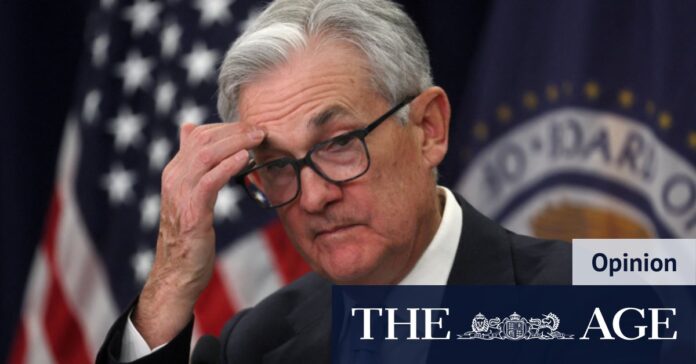[ad_1]
Henceforth, the economy can cope with sharply higher borrowing costs. We are never going back to zero rates and negative bond yields, or so goes the thinking.
If so, this has vast implications for global borrowing costs and the market value of $US140 trillion ($215 trillion) of outstanding bonds. It is the burning question in world finance today.

The IMF predicts US deficits of 7 per cent as far as the eye can see, pushing public debt to 137 per cent of GDP by 2028 if nothing is done.Credit: Michael Nagle/Bloomberg
But not everybody thinks they are right, least of all Wicksellians. A recent article in the journal Central Banking argues that this flies in the face of both orthodox monetary theory and what is actually happening to global credit.
Philip Turner, a former top official at the Bank for International Settlements, and Marina Misev from the University of Basel, warn that central banks are being misled by false assumptions about R* into dangerous overtightening, risking a global credit crunch and an asset crash.
They argue that the natural rate is determined by whether private credit aggregates – bank loans and debt securities – are rising or falling. They have been falling at alarming rates across the West.
Bernard Connolly, author of You Always Hurt the One You Love: Central Banks and the Murder of Capitalism, predicts that the neutral rate will plummet as soon as fiscal worries force countries to tackle their budget deficits, a process already underway in Europe.
“I do not think that real long rates at their present levels are sustainable,” he said.
The average deficit was stable near 2.4 per cent of GDP in the advanced economies before COVID It is 5.2 per cent this year, according to IMF data, but is starting to fall rapidly.
The US is an egregious exception with a deficit near 8 per cent on a quarterly basis. “It should be in balance at this stage of the cycle. It doesn’t get better than this,” said Moritz Kraemer, former head of sovereign ratings at Standard & Poor’s.
The IMF predicts US deficits of 7 per cent as far as the eye can see, pushing public debt to 137 per cent of GDP by 2028 if nothing is done. Nothing is being done.
S&P and Fitch have already stripped the US of its AAA rating. Moody’s put the US on negative watch last Friday, citing the perennial soap opera over the debt ceiling. Needless to say, such downgrades change nothing. America issues the paramount reserve currency and is still the world’s military colossus. It can get away with fiscal murder.
Others are not so lucky. America is lifting borrowing costs across the world by crowding out the bond markets with debt issuance and roll-overs running at an $US8 trillion annual pace. Spillovers have pushed a clutch of countries into the crosshairs of the bond vigilantes.
“I think the UK could be vulnerable again if the Tories cut taxes too much or if they do it in a fashion that doesn’t raise economic productivity. The bond markets can turn on you very fast if they don’t believe what you are doing,” said Dowding.
It is hard to see how putative cuts in stamp duty and inheritance tax, being floated as a pre-Christmas bonus, can help to lift the British economic speed limit. What the UK needs is lower business tax and infrastructure projects with a multiplier above 1.0 that pay for themselves via higher growth.
Loading
The iron law of sovereign debt management is that you don’t have to outrun the cheetah, you have to outrun the weakest herbivores of the herd. Fortunately, the UK is no longer the first target.
The UK is still on probation after the Truss episode but Rishi Sunak’s technocrat government has won a degree of Davosian respectability, no doubt enhanced further by the defenestration of Suella Braverman and the return of David Cameron as the face of British diplomacy. Davos hates the culture war.
Revised data shows that the UK economy has performed no worse than the eurozone over recent years. What I notice in global economic commentary is less and less talk of Britain as a Gothic horror story.
The vigilantes are instead eyeing Italy, where Giorgia Meloni’s honeymoon is over and what remains is the same old story: a half-reformed economy with a poisonous mix of near-zero growth, bad demographics and a debt ratio of 140 per cent of GDP.
“The really ugly mix will come in countries where interest rates are pulled up by global or regional factors without a corresponding increase in growth,” said Neil Shearing, chief economist at Capital Economics.
“Italy’s long-term debt dynamics are grim and the country operates within the straitjacket of monetary union. We doubt it will stay out of the firing line forever,” he said.
‘Politicians have got into the habit of spending money like there is no tomorrow, and the population likes it. Sooner or later the bond market is going to throw another tantrum.’
Mark Dowding from BlueBay Asset Management.
Euro membership twists the knife for the eurozone periphery. These countries no longer have a sovereign central bank and cannot print their way out of trouble. They are like a company and can go bankrupt, à la grecque, unless and until Germany agrees to rescue them.
You could argue that debt markets have already pricked the global fiscal bubble, setting in motion slow debt deflation. The eurozone has one foot in recession and the collapse in credit points to a protracted slump.
The jump in 10-year US Treasury yields to 4.5-5 per cent is percolating through the financial system and commercial real estate markets. The damage accumulates month after month as borrowers must refinance on hostile terms.
In a sense, the bond vigilantes have shown by their actions that they will not fund America’s fiscal degradation at tolerable cost. They will not cover the hole left by two sets of major tax cuts. They are demanding a premium to pay for a welfare state (entitlements) that has risen to 75 per cent of all US federal spending and is patently out of control.
The consensus New Keynesian view is that the world has jumped to a new regime of much higher interest rates and governments must cut their fiscal cloth accordingly.
The rival Wicksellian view is that the world economy cannot endure such high rates for long. If the Wicksellians are right, central banks will discover that R* has crumbled beneath their feet.
Loading
The ECB and then the Fed will have to carry out a violent policy pivot, slash rates, and ultimately mop up debt with fresh QE.
Almost nobody in the markets is prepared for that surprise.
Telegraph, London
The Business Briefing newsletter delivers major stories, exclusive coverage and expert opinion. Sign up to get it every weekday morning.
[ad_2]
Source link


